Dependence of Soil Moisture and Strength on Topography and Vegetation Varies Within a SMAP Grid Cell
Abstract
1. Introduction
2. Materials and Methods
2.1. Study Site and Sampling Strategy
2.2. Data Collection
2.2.1. Topography and Vegetation
2.2.2. Soil Moisture
2.2.3. Soil Strength
2.2.4. Soil Composition
2.3. Correlation and Slope Analyses
3. Results
3.1. Topography, Vegetation, and SSURGO
3.2. Laboratory Soil Composition
3.3. Soil Moisture and Strength
3.4. Relationships Between Soil Moisture/Strength and Regional Attributes
4. Discussion
5. Conclusions
- The strength of the relationships between soil moisture and topographic, vegetation, and soil composition attributes can vary substantially within a SMAP grid cell. Soil moisture is strongly correlated to topography in Region A and weakly correlated to topography in Region B but has few significant correlations with topography in Regions C and D. Soil moisture is strongly correlated to vegetation in Regions A and C, less correlated in Region D, and poorly correlated in Region B. Soil moisture is most correlated with soil attributes in Region A, followed by Regions C and D, with Region B having weak correlations.
- The slopes of the relationships between soil moisture and topographic, vegetation, and soil composition attributes can also vary substantially within a SMAP grid cell. Region A has the greatest slopes for relationships between soil moisture and topography. Regions A and C have greater slopes for relationships of soil moisture with vegetation and soil than Regions B and D.
- The strength of the relationships between soil strength and topographic, vegetation, and soil composition attributes can vary within a SMAP grid cell. Regions A, B, and D have weak correlations between soil strength and topography, while Region C has few significant correlations. Region D is the only region with consistent significant correlations between soil strength and compositional attributes.
Supplementary Materials
Author Contributions
Funding
Data Availability Statement
Acknowledgments
Conflicts of Interest
Abbreviations
References
- Wulfsohn, D.; Adams, B.; Fredlund, D. Application of unsaturated soil mechanics for agricultural conditions. Can. Agric. Eng. 1996, 38, 173–181. [Google Scholar]
- Priddy, J.; Berney, E.; Peters, J. Effects of near-surface hydrology on soil strength and mobility. Geol. Soc. Lond. Spec. Publ. 2012, 362, 301–320. [Google Scholar] [CrossRef]
- Uusitalo, J.; Ala-Ilomäki, J.; Lindeman, H.; Toivio, J.; Siren, M. Modelling soil moisture–soil strength relationship of fine-grained upland forest soils. Silva Fenn. 2019, 53. [Google Scholar] [CrossRef]
- Schönauer, M.; Prinz, R.; Väätäinen, K.; Astrup, R.; Pszenny, D.; Lindeman, H.; Jaeger, D. Spatio-temporal prediction of soil moisture using soil maps, topographic indices, and SMAP retrievals. Int. J. Appl. Earth Obs. Geoinf. 2022, 108, 102730. [Google Scholar] [CrossRef]
- Fredlung, D. Unsaturated soil mechanics in engineering practice. J. Geotech. Geoenviron. Eng. 2006, 132, 286–321. [Google Scholar] [CrossRef]
- Stevens, M.; Towne, B.; Mason, G.; Priddy, J.; Osorio, J.; Barella, C. Procedure for One-Pass Vehicle Cone Index Determination for Acquisition Support; ERDC/GSL SR-13-2; US Army Corps of Engineers: Washington, DC, USA, 2013.
- Pauly, M.J. Modeling and Field Evaluation of Unsaturated Soil Strength for Vehicle Mobility. Master’s Thesis, Colorado State University, Fort Collins, CO, USA, 2019. [Google Scholar]
- Jurkat, M.P.; Nuttall, P.W.; Haley, P.W. The U.S. Army mobility model (AMM-75). In WES Papers from 5th International Conference International Society for Terrain-Vehicle Systems; Waterways Experiment Station: Vicksburg, MS, USA, 1975; pp. 5–52. [Google Scholar]
- Haley, P.W.; Jurkat, M.P.; Brady, P.M. NATO Reference Mobility Model, Edition I User’s Guide; Technical Report 12503; Tank-Automotive Research and Development Command: Warren, MI, USA, 1979. [Google Scholar]
- Ahlvin, R.B.; Haley, P.W. NATO Reference Mobility Model, Edition II User’s Guide; GL-92-19; Waterways Experiment Station: Vicksburg, MS, USA, 1992. [Google Scholar]
- McCoullough, M.; Jayakumar, P.; Dasch, J.; Gorsich, D. The next generation NATO reference mobility model development. J. Terramech. 2017, 73, 49–60. [Google Scholar] [CrossRef]
- Choi, K.K.; Gaul, N.; Jayakumar, P.; Wasfy, T.M. Framework of reliability-based stochastic mobility map for next generation NATO reference mobility model. J. Comput. Nonlinear Dynam. 2019, 14, 021012. [Google Scholar] [CrossRef]
- Gao, H.; Wood, E.F.; Jackson, T.J.; Drusch, M.; Bindlish, R. Using TRMM/TMI to retrieve surface soil moisture over the southern United States from 1998 to 2002. J. Hydrometeorol. 2006, 7, 23–38. [Google Scholar] [CrossRef]
- Wagner, W.; Hahn, S.; Kidd, R.; Melzer, T.; Bartalis, Z.; Hasenauer, S.; Figa-Saldaña, J.; de Rosnay, P.; Jann, A.; Schneider, S.; et al. The ASCAT soil moisture product: A review of its specifications, validation results, and emerging applications. Meteorol. Z. 2013, 22, 5–33. [Google Scholar] [CrossRef]
- Kachi, M.; Naoki, K.; Hori, M.; Imaoka, K. AMSR2 validation results. In Proceedings of the 2013 IEEE International Geoscience and Remote Sensing Symposium—IGARSS, Melbourne, VIC, Australia, 21–26 July 2013; pp. 831–834. [Google Scholar] [CrossRef]
- Kerr, Y.; Wigneron, J.; Delwart, S.; Cabot, F.; Boutin, J.; Escorihuela, M.; Font, J.; Reul, N.; Gruhier, C.; Juglea, S.; et al. The SMOS mission: New tool for monitoring key elements of the global water cycle. Proc. IEEE 2010, 98, 666–687. [Google Scholar] [CrossRef]
- O’Neill, P.; Entekhabi, D.; Njoku, E.; Kellogg, K. The NASA soil moisture active passive (SMAP) mission: Overview. In Proceedings of the 2010 IEEE International Geoscience and Remote Sensing Symposium, Honolulu, HI, USA, 25–30 July 2010; pp. 3236–3239. [Google Scholar] [CrossRef]
- Merlin, O.; Chebouni, A.G.; Kerr, Y.H.; Goodrich, D.C. A downscaling method for distributing surface soil moisture within a microwave pixel: Application to the monsoon ’90 data. Remote Sens. Environ. 2006, 101, 379–389. [Google Scholar] [CrossRef]
- Sadeghi, M.; Babaeian, E.; Tuller, M.; Jones, S.B. The optical trapezoid model: A novel approach to remote sensing of soil moisture applied to Sentinel-2 and Landsat-8 observations. Remote Sens. Environ. 2017, 198, 52–68. [Google Scholar] [CrossRef]
- Peng, J.; Loew, A.; Zhang, S.; Wang, J.; Niesel, J. Spatial downscaling of satellite soil moisture data using a vegetation temperature condition index. IEEE Trans. Geosci. Remote Sens. 2016, 54, 558–566. [Google Scholar] [CrossRef]
- Fang, B.; Lakshmi, V.; Bindlish, R.; Jackson, T. AMSR2 soil moisture downscaling using temperature and vegetation data. Remote Sens. 2018, 10, 1575. [Google Scholar] [CrossRef]
- Singh, A.; Gaurav, K. Deep Learning and Data Fusion to Estimate Surface Soil Moisture from Multi-Sensor Satellite Images. Sci. Rep. 2023, 13, 2251. [Google Scholar] [CrossRef] [PubMed]
- Fuentes, I.; Padarian, J.; Vervoort, R.W. Towards near Real-Time National-Scale Soil Water Content Monitoring Using Data Fusion as a Downscaling Alternative. J. Hydrol. 2022, 609, 127705. [Google Scholar] [CrossRef]
- Vergopolan, N.; Chaney, N.W.; Beck, H.E.; Pan, M.; Sheffield, J.; Chan, S.; Wood, E.F. Combining Hyper-Resolution Land Surface Modeling with SMAP Brightness Temperatures to Obtain 30-m Soil Moisture Estimates. Remote Sens. Environ. 2020, 242, 111740. [Google Scholar] [CrossRef]
- Coleman, M.L.; Niemann, J.D. Controls on topographic dependence and time-instability in catchment-scale soil moisture patterns. Water Resour. Res. 2013, 49, 1625–1642. [Google Scholar] [CrossRef]
- Ranney, K.J.; Niemann, J.D.; Lehman, B.M.; Green, T.R.; Jones, A.S. A method to downscale soil moisture to fine resolutions using topographic, vegetation and soil data. Adv. Water Resour. 2015, 76, 81–96. [Google Scholar] [CrossRef]
- Cowley, G.S.; Niemann, J.D.; Green, T.R.; Seyfried, M.S.; Jones, A.S.; Grazaitis, P.J. Impacts of precipitation and potential evapotranspiration patterns on downscaling soil moisture in regions with large topographic relief. Water Resour. Res. 2017, 53, 1553–1574. [Google Scholar] [CrossRef]
- Deshon, J.P.; Niemann, J.D.; Green, T.R.; Jones, A.S.; Grazaitis, P.J. Stochastic analysis and probabilistic downscaling of soil moisture in small catchments. J. Hydrol. 2020, 585, 124711. [Google Scholar] [CrossRef]
- Ali, G.; Roy, A.; Legendre, P. Spatial relationships between soil moisture patterns and topographic variables at multiple scales in a humid temperate forested catchment. Water Resour. Res. 2010, 46. [Google Scholar] [CrossRef]
- Mascaro, G.; Vivoni, E.; Deidda, R. Soil moisture downscaling across climate regions and its emergent properties. J. Geophys. Res. 2011, 116, 3128–3142. [Google Scholar] [CrossRef]
- Yu, B.; Liu, G.; Liu, Q.; Feng, J.; Wang, X.; Han, G.; Haung, C. Effects of micro-topography and vegetation type on soil moisture in a large gully on the Loess Plateau of China. Hydrol. Res. 2018, 46, 1255–1270. [Google Scholar] [CrossRef]
- Liang, W.; Li, S.; Hung, F. Analysis of the contributions of topographic, soil, and vegetation features on the spatial distributions of surface soil moisture in a steep natural forested headwater catchment. Hydrol. Process. 2017, 32, 3796–3809. [Google Scholar] [CrossRef]
- Mohanty, B.P.; Famiglietti, J.S.; Skaggs, T.H. Evolution of soil moisture spatial structure in a mixed vegetation pixel during the Southern Great Plains 1997 (SGP97) hydrology experiment. Water Resour. Res. 2000, 36, 3675–3686. [Google Scholar] [CrossRef]
- Western, A.; Zhou, S.; Grayson, R.; McMahon, T.; Bloschl, G.; Wilson, D. Spatial correlation of soil moisture in small catchments and its relationship to dominant spatial hydrological processes. J. Hydrol. 2004, 256, 113–134. [Google Scholar] [CrossRef]
- Lin, H.; Kogelmann, W.; Walker, C.; Burns, M. Soil moisture patterns in a forested catchment: A hydropedological perspective. Geoderma 2006, 131, 345–368. [Google Scholar] [CrossRef]
- Kim, S.; Heysun, L.; Woo, N.; Kim, J. Soil moisture monitoring on a steep hillside. Hydrol. Process. 2007, 21, 2823–2964. [Google Scholar] [CrossRef]
- Rosenbaum, U.; Bogena, H.R.; Herbst, M.; Huisman, J.A.; Peterson, T.J.; Weuthen, A.; Western, A.W.; Vereecken, H. Seasonal and event dynamics of spatial moisture patterns at the small catchment scale. Water Resour. Res. 2012, 48. [Google Scholar] [CrossRef]
- Fathololoumi, S.; Vaezi, A.R.; Firozjaei, M.K.; Biswas, A. Quantifying the effect of surface heterogeneity on soil moisture across regions and surface characteristic. J. Hydrol. 2021, 596, 126132. [Google Scholar] [CrossRef]
- Fischer, S.; Niemann, J.D.; Scalia, J.; Bullock, M.D.; Proulx, H.E.; Kim, B.; Green, T.R.; Grazaitis, P.J. Assessing the influence of model inputs on performance of the EMT+VS soil moisture downscaling model for a large foothills region in Northern Colorado. J. Hydrol. 2025, 650, 132397. [Google Scholar] [CrossRef]
- Chan, S.K.; Bindlish, R.; O’Neill, P.; Jackson, T.; Njoku, E.; Dunbar, S.; Kerr, Y. Development and assessment of the SMAP enhanced passive soil moisture product. Remote Sens. Environ. 2018, 204, 931–941. [Google Scholar] [CrossRef] [PubMed]
- O’Neill, P.E.; Chan, S.; Njoku, E.G.; Jackson, T.; Bindlish, R.; Chaubell, J.; Colliander, A. SMAP Enhanced L3 Radiometer Global and Polar Grid Daily 9 km EASE-Grid Soil Moisture, Version 5; NASA National Snow and Ice Data Center Distributed Active Archive Center: Boulder, CO, USA, 2021. [CrossRef]
- Western, A.W.; Grayson, R.B.; Blöschl, G.; Willgoose, G.R.; McMahon, T.A. Observed spatial organization of soil moisture and its relation to terrain indices. Water Resour. Res. 1999, 35, 797–810. [Google Scholar] [CrossRef]
- Wilson, D.J.; Western, A.W.; Grayson, R.B. A terrain and data-based method for generating the spatial distribution of soil moisture. Adv. Water Resour. 2005, 28, 43–54. [Google Scholar] [CrossRef]
- Perry, M.A.; Niemann, J.D. Generation of soil moisture patterns at the catchment scale by EOF interpolation. Hydrol. Earth Syst. Sci. 2008, 12, 39–53. [Google Scholar] [CrossRef]
- Eylander, J.; Bieszczad, J.; Ueckermann, M.; Peters, J.; Brooks, C.; Audette, W.; Ekegren, M. Geospatial weather affected terrain conditions and hazards (GeoWATCH) description and evaluation. Environ. Model. Softw. 2023, 160, 105606. [Google Scholar] [CrossRef]
- U.S. Geological Survey (USGS). USGS 1/3 Arc Second n41w106 20221118; U.S. Geological Survey: Reston, VA, USA, 2022.
- Tarboton, D.G. Terrain Analysis using Digital Elevation Models (TAUDEM). In Hydrology Research Group-Terrain Analysis Using Digital Elevation Models (Taudem); Utah State University: Logan, UT, USA, 2008. [Google Scholar]
- Lee, R. Potential insolation as a topoclimatic characteristic of drainage basins. Hydrol. Sci. J. 1964, 9, 27–41. [Google Scholar] [CrossRef]
- Swift, L.W., Jr. Algorithm for solar radiation on mountain slopes. Water Resour. Res. 1976, 12, 108–112. [Google Scholar] [CrossRef]
- Dingman, S.L. Physical Hydrology; Waveland Press: Long Grove, IL, USA, 1994; pp. 571–577. [Google Scholar]
- European Space Agency (ESA). Sentinel 2 MSI-Level 2A. Copernicus Open Access; European Space Agency: Paris, France, 2016. [Google Scholar]
- Kriegler, F.J.; Malila, W.A.; Nalepka, R.F.; Richardson, W. Preprocessing transformations and their effect on multispectral recognition. In Proceedings of the Sixth International Symposium on Remote Sensing of Environment, Ann Arbor, MI, USA, 13–16 October 1969; pp. 97–131. [Google Scholar]
- Liu, H.Q.; Huete, A. A Feedback based modification of the NDVI to minimize canopy background and atmospheric noise. IEEE Trans. Geosci. Remote Sens. 1995, 33, 457–465. [Google Scholar] [CrossRef]
- Huete, A.R.; Liu, H.Q.; Batchily, K.; van Leeuwen, W. A comparison of vegetation indices over a global set of TM images for EOS-MODIS. Remote Sens. Environ. 1997, 59, 440–451. [Google Scholar] [CrossRef]
- Soil Survey Staff, Natural Resources Conservation Service, United Stated Department of Agriculture. Web Soil Survey. Available online: http://websoilsurvey.nrcs.usda.gov/ (accessed on 1 July 2023).
- Stevens Water Monitoring System, Inc. Comprehensive Stevens HydraProbe User’s Manual; Stevens Water Monitoring System: Portland, OR, USA, 2018. [Google Scholar]
- Humboldt Mfg. Digital Proving Ring Penetrometer: Product Manual; Humboldt Mfg: Elgin, IL, USA, 2023. [Google Scholar]
- METER Group. PARIO User Manual V2017/12; METER Group AG: Munich, Germany, 2017. [Google Scholar]
- ASTM D7928-21; Standard Test Methods for Particle-Size Distribution (Gradation) of Soils Using the Sedimentation (Hydrometer) Analysis. American Society for Testing and Materials: West Conshohocken, PA, USA, 2021.
- Durner, W.; Iden, S.C.; von Unold, G. The integral suspension pressure method (ISP) for precise particle-size analysis by gravitational sedimentation. Water Resour. Res. 2017, 53, 33–48. [Google Scholar] [CrossRef]
- ASTM D6913/D6913M-17; Standard Test Methods for Particle-Size Distribution (Gradation) of Soils Using Sieve Analysis. American Society for Testing and Materials: West Conshohocken, PA, USA, 2017.
- Cosby, B.J.; Hornberger, G.M.; Clapp, R.B.; Ginn, T.R. A statistical exploration of the relationships of soil-moisture characteristics to the physical properties of soils. Water Resour. Res. 1984, 20, 682–690. [Google Scholar] [CrossRef]
- United States Department of Agriculture (USDA). Soil Taxonomy: A Basic System of Soil Classification for Making and Interpreting Soil Surveys; Government Printing Office: Washington, DC, USA, 1975.
- ASTM D4318-17e1; Standard Test Methods for Liquid Limit, Plastic Limit, and Plasticity Index of Soils. American Society for Testing and Materials: West Conshohocken, PA, USA, 2010.
- ASTM D2487-17e1; Standard Practice for Classification of Soils for Engineering Purposes (Unified Soil Classification System). American Society for Testing and Materials: West Conshohocken, PA, USA, 2017.
- ASTM D2974-20e1; Standard Test Methods for Determining the Water (Moisture) Content, Ash Content, and Organic Material of Peat and Other Organic Soils. American Society for Testing and Materials: West Conshohocken, PA, USA, 2020.
- Rezanezhad, F.; Price, J.S.; Quinton, W.L.; Lennartz, B.; Milojevic, T.; Van Cappellen, P. Structure of peat soils and implications for water storage, flow and solute transport: A review update for geochemists. Chem. Geol. 2016, 429, 75–84. [Google Scholar] [CrossRef]
- Casagrande, A. Classification and identification of soils. Trans. Am. Soc. Civil Eng. 1948, 113, 901–930. [Google Scholar] [CrossRef]
- Brooks, R.H.; Corey, A.T. Hydraulic Properties of Porous Media; Hydrology Papers; Colorado State University: Fort Collins, CO, USA, 1964. [Google Scholar]
- van Genuchten, M.T.; Leij, F.J.; Yates, S.R. The RETC Code for Quantifying the Hydraulic Functions of Unsaturated Soils; U.S. Salinity Laboratory, U.S. Department of Agriculture, Agricultural Research Service: Riverside, CA, USA, 1991. [Google Scholar]
- Moeslund, J.; Arge, L.; Bocher, P.; Dalgaard, T.; Odgaard, M.; Nygaard, B.; Svenning, J. Topographically controlled soil moisture is the primary driver of local vegetation patterns across a lowland region. Ecosphere 2013, 4, 1–26. [Google Scholar] [CrossRef]
- Fredlund, D.G.; Morgenstern, N.R.; Widger, R.A. The shear strength of unsaturated soils. Can. Geotech. J. 1978, 15, 313–321. [Google Scholar] [CrossRef]
- Lu, N.; Godt, J.; Wu, D. A closed-form equation for effective stress in variably saturated soil. Water Resour. Res. 2010, 46. [Google Scholar] [CrossRef]


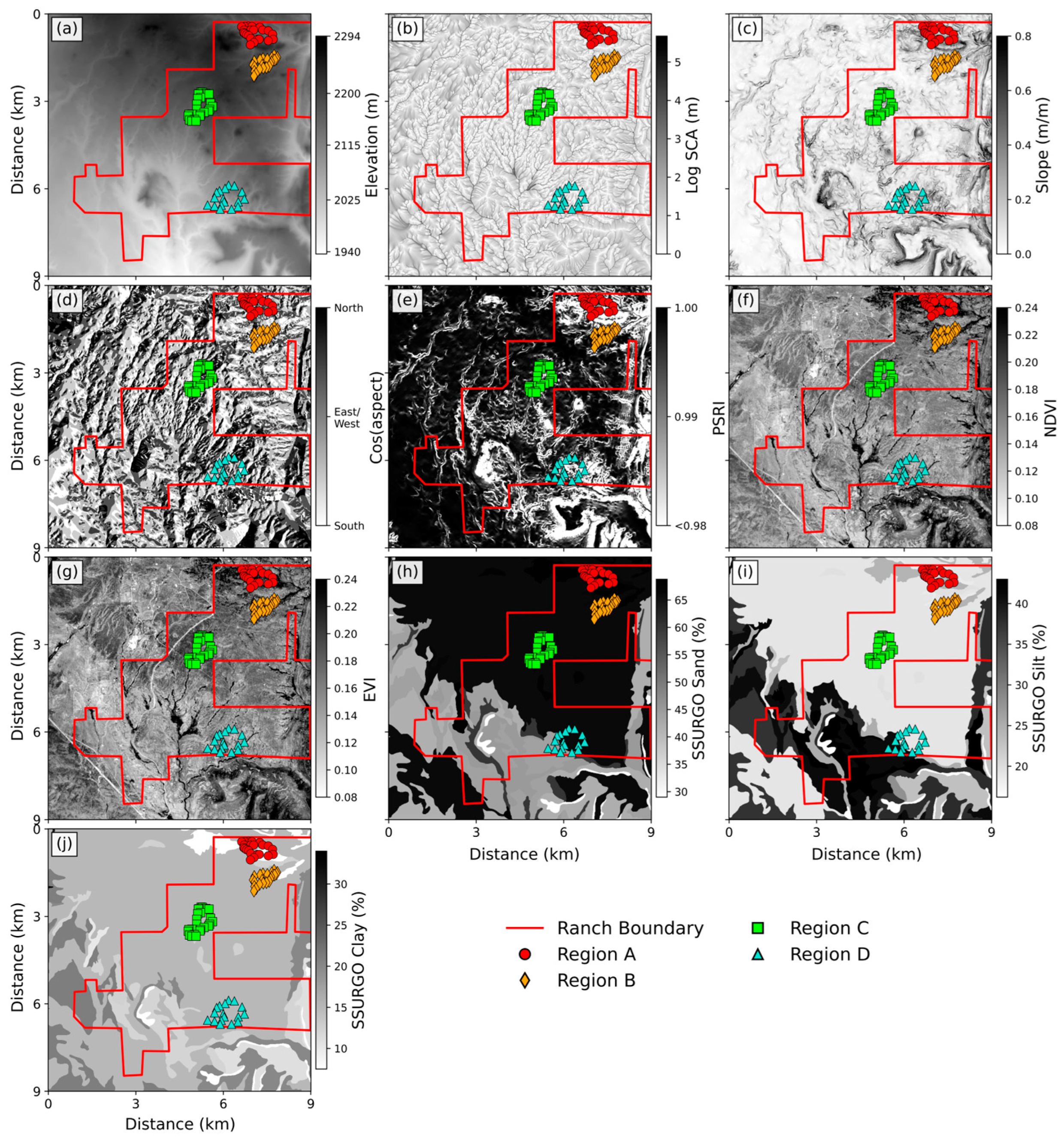
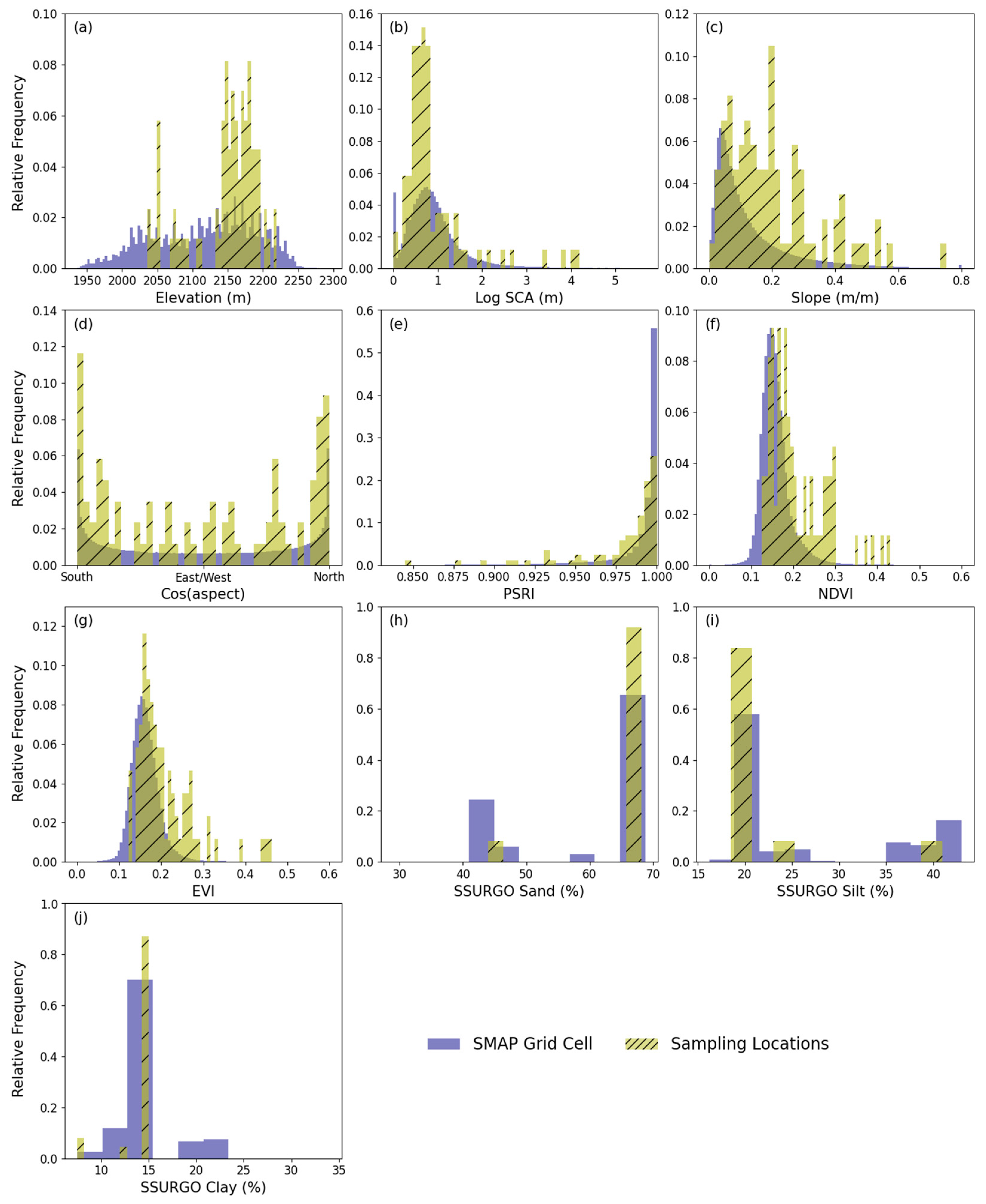

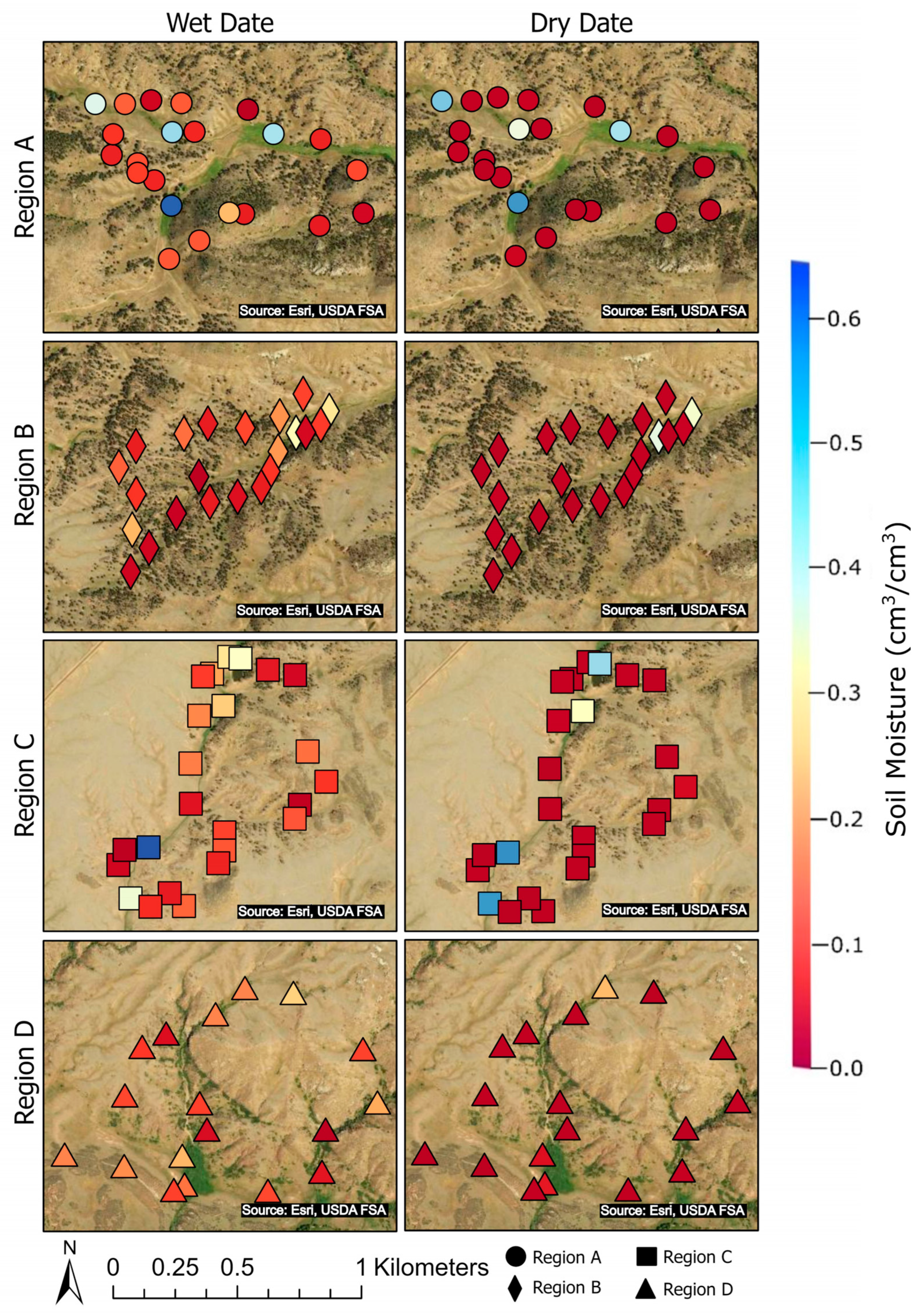

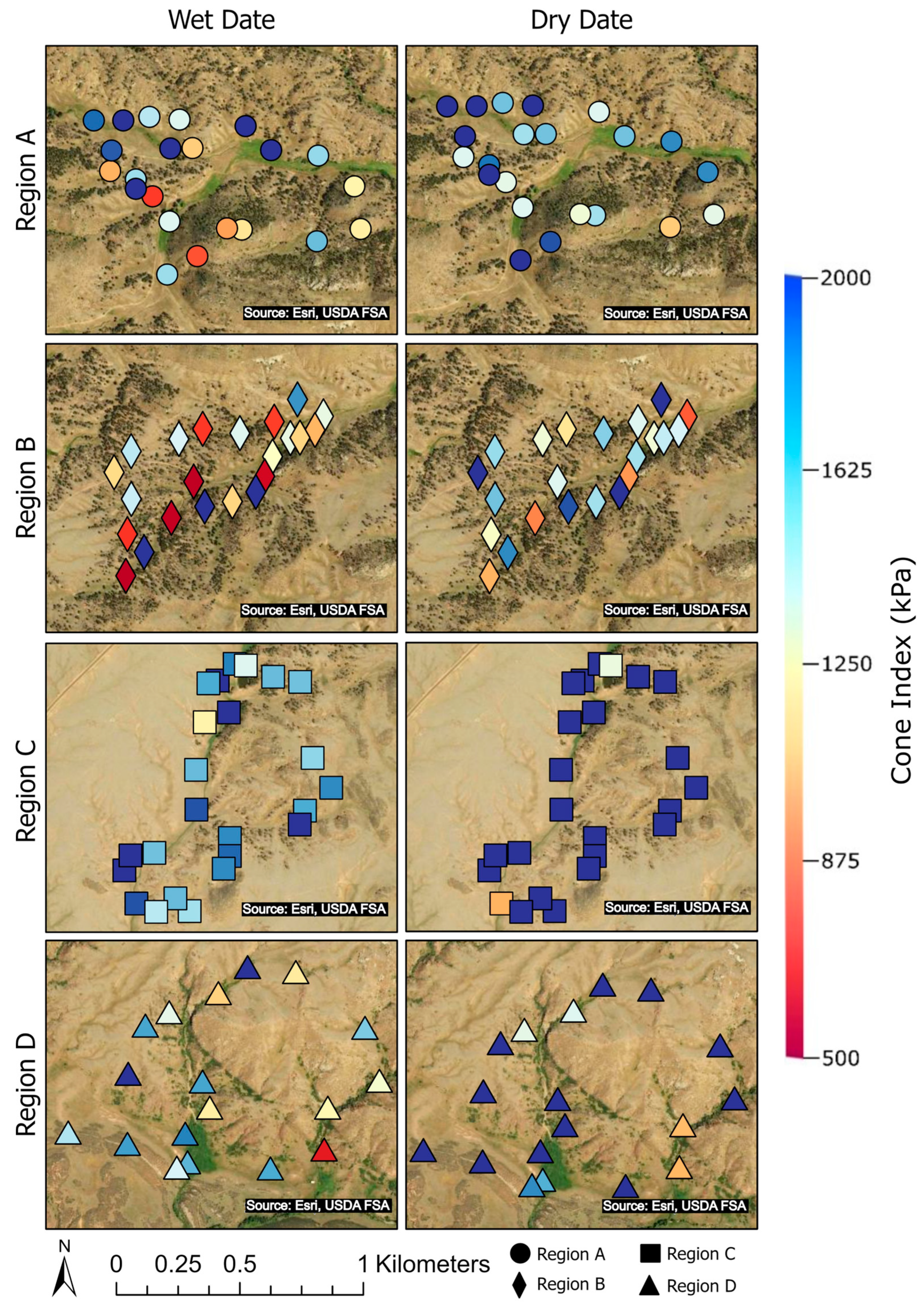
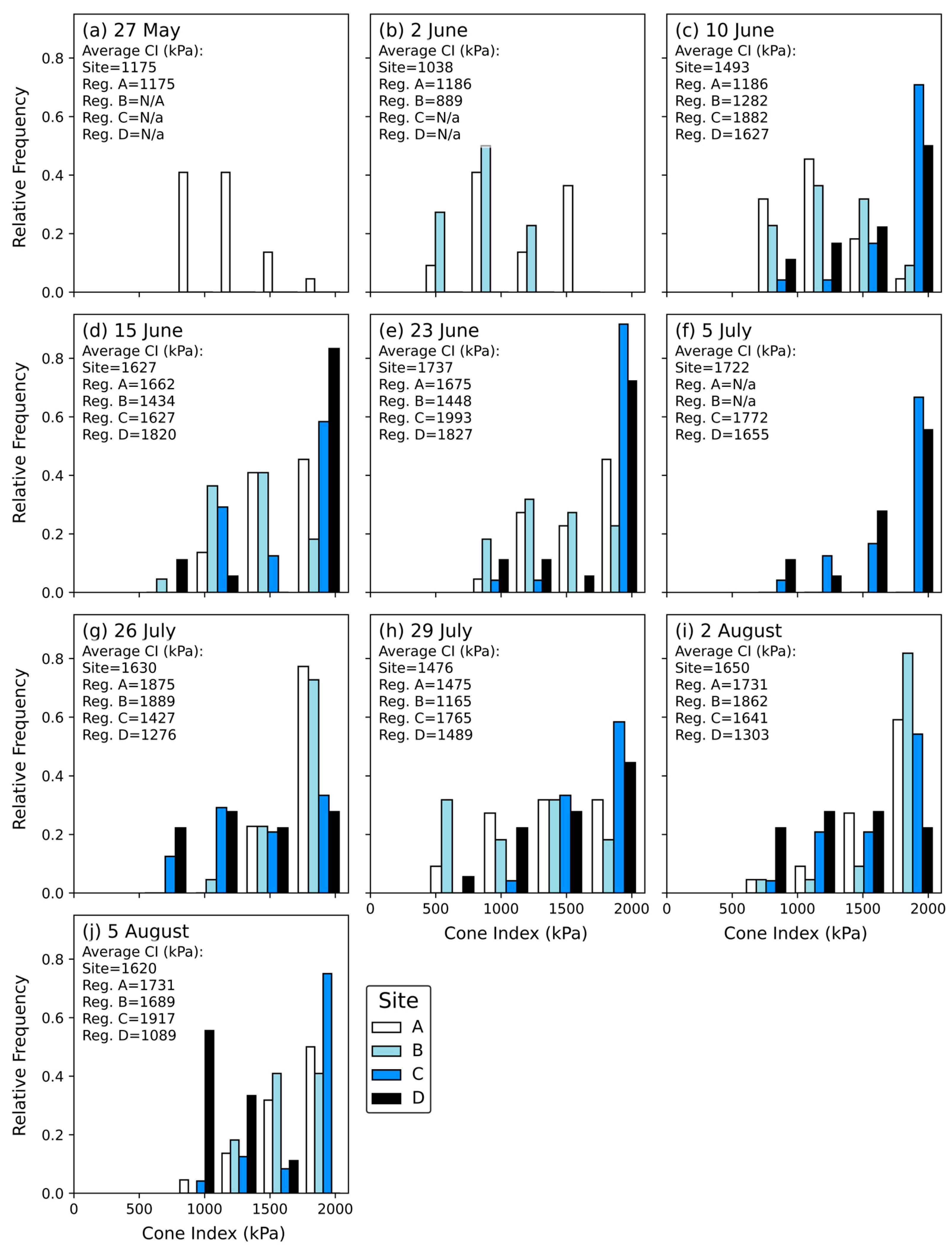
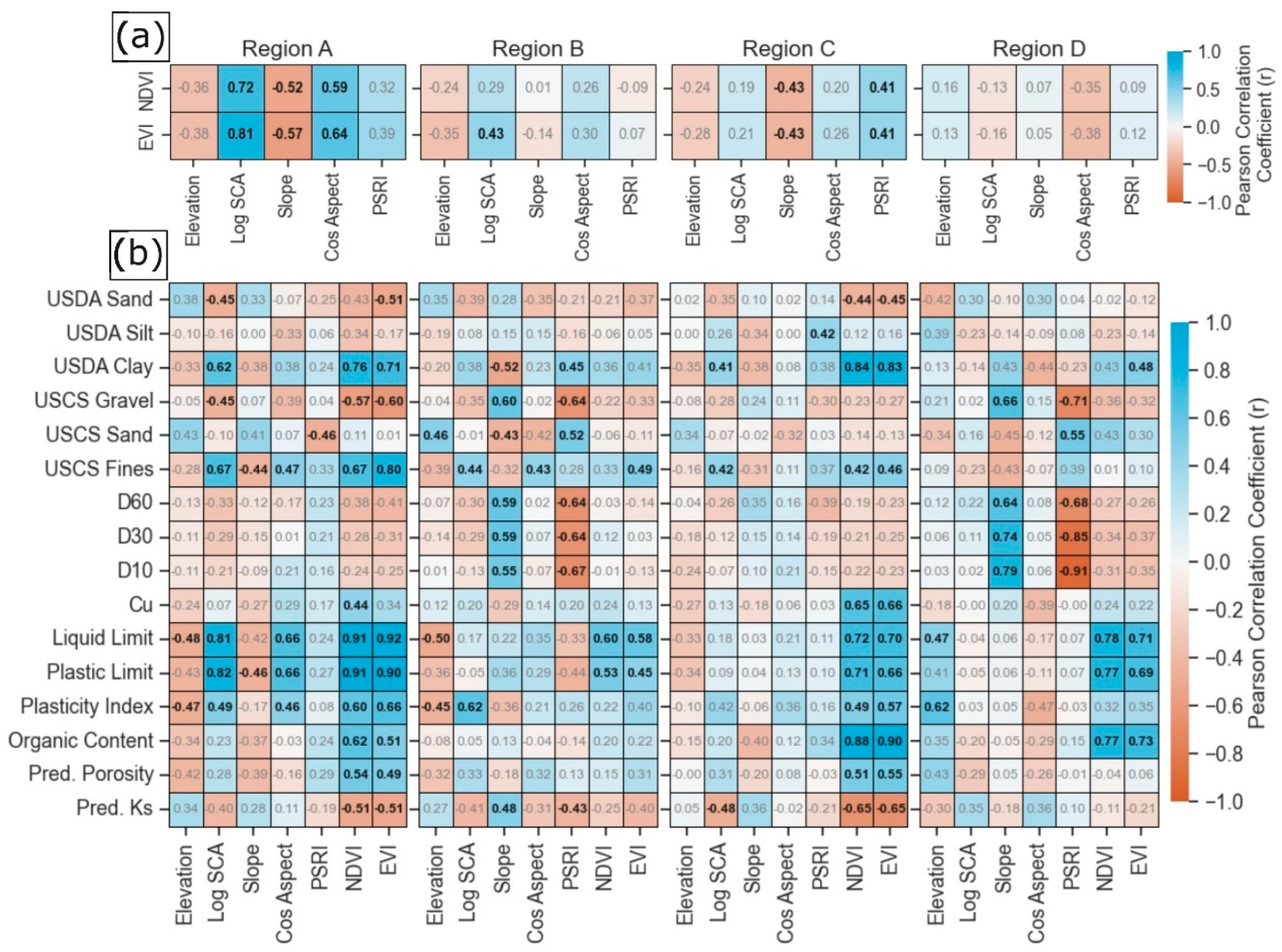


Disclaimer/Publisher’s Note: The statements, opinions and data contained in all publications are solely those of the individual author(s) and contributor(s) and not of MDPI and/or the editor(s). MDPI and/or the editor(s) disclaim responsibility for any injury to people or property resulting from any ideas, methods, instructions or products referred to in the content. |
© 2025 by the authors. Licensee MDPI, Basel, Switzerland. This article is an open access article distributed under the terms and conditions of the Creative Commons Attribution (CC BY) license (https://creativecommons.org/licenses/by/4.0/).
Share and Cite
Bindner, J.R.; Proulx, H.; Wickham, K.; Niemann, J.D.; Scalia, J., IV; Green, T.R.; Grazaitis, P.J. Dependence of Soil Moisture and Strength on Topography and Vegetation Varies Within a SMAP Grid Cell. Hydrology 2025, 12, 34. https://doi.org/10.3390/hydrology12020034
Bindner JR, Proulx H, Wickham K, Niemann JD, Scalia J IV, Green TR, Grazaitis PJ. Dependence of Soil Moisture and Strength on Topography and Vegetation Varies Within a SMAP Grid Cell. Hydrology. 2025; 12(2):34. https://doi.org/10.3390/hydrology12020034
Chicago/Turabian StyleBindner, Joseph R., Holly Proulx, Kevin Wickham, Jeffrey D. Niemann, Joseph Scalia, IV, Timothy R. Green, and Peter J. Grazaitis. 2025. "Dependence of Soil Moisture and Strength on Topography and Vegetation Varies Within a SMAP Grid Cell" Hydrology 12, no. 2: 34. https://doi.org/10.3390/hydrology12020034
APA StyleBindner, J. R., Proulx, H., Wickham, K., Niemann, J. D., Scalia, J., IV, Green, T. R., & Grazaitis, P. J. (2025). Dependence of Soil Moisture and Strength on Topography and Vegetation Varies Within a SMAP Grid Cell. Hydrology, 12(2), 34. https://doi.org/10.3390/hydrology12020034





